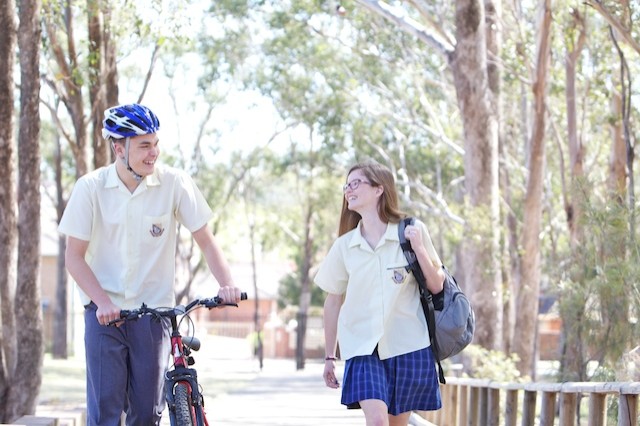Sarah's story
Sarah is an enthusiastic Year 8 student who is highly motivated and confident with meeting new people and speaking and performing in front of others. Sarah tends to perform well academically, but can easily become distracted by other students and gets out of her seat a lot to see what’s happening both inside and outside the classroom.
Sarah talks constantly about off-topic things, and this is most noticeable during quiet class activities. She often calls out answers before her teachers have finished asking questions. Turn-taking is very difficult for Sarah, and she regularly intrudes into the activities of others. Sarah was diagnosed with Attention-Deficit/Hyperactivity Disorder (ADHD) in Year 6.

1. What are Sarah's strengths and what has been helpful so far?
Sarah's strengths:
- Sarah is enthusiastic and highly motivated.
- Sarah is confident with meeting new people and speaking in front of others.
- Sarah likes to do well.
- Sarah likes making origami.
- Sarah’s family is learning about ADHD and are seeking support.
What has been helpful:
- Sitting Sarah at the front of the class has helped her listen and follow instructions.
- Sarah is sometimes more motivated when a task/outcome links to a personal interest.
- Sarah works well when paired with conscientious and studious students.
- Concentrating on tasks step-by-step has been helpful when Sarah needs to complete larger or more complex tasks.
What has not been helpful:
- Sarah is not likely to stay on-task, and less likely to stay in her seat, in large groups.
- Noises inside and outside of the classroom greatly disrupt Sarah’s concentration levels.
2. What is the goal and why is it important?
The goal:
The overall goals are for Sarah to complete tasks in realistic timeframes decided between her and her teacher, and to do this without too many distractions or interruptions.
To monitor achievement of goals and behaviours, Sarah will use a self-monitoring form. These goals may be developed into growth goals as part of the collaborative curriculum planning process and included in Sarah’s Personalised Learning and Support Plan.
Why:
The ability to complete activities on time and self-monitor her progress is important for many areas of life, both currently, and for Sarah’s future independence, confidence and workforce participation.
Personalised learning and support will ensure Sarah enjoys a rigorous and meaningful education.
3. What evidence-based strategies can be used to reach the goal?
Strengths
- Sarah is enthusiastic and highly motivated.
- Sarah likes to do well.
Strategy
- Sarah and her teachers will use the self-monitoring form daily/weekly to list and monitor some behaviours that will help her stay focused on tasks. Some examples might include: Today, I will “raise my hand if I have questions to ask”, “wait for my turn to speak”, “write notes in my notebook while listening to my teacher”, “move to the standing desk if I need a break from sitting”.
- Sarah’s teachers will build self-reflection into learning tasks, so Sarah can identify what is helping her (for example; what did you do while listening to your teacher speak? How did you feel when you spoke after raising your hand?
__________________________________________________________________________________________________________________________
Strengths
- Sitting Sarah at the front of the class has helped her listen and follow instructions.
- Concentrating on tasks step-by-step has been helpful when Sarah needs to complete larger or more complex tasks.
- Sarah likes making origami.
Strategy
- Sarah has agreed to sit near the front of the class so her teachers can gain and maintain eye contact with her, and discreetly remind her to stay seated and on-task.
- Complex and long tasks will be broken down to multiple small tasks. A realistic time frame for each task will be established.
- Visual support, such as a list of broken down tasks, timeframes and short, clear instructions displayed on a sheet of paper on her desk will be used.
- Sarah’s teachers will provide discreet prompts and support during independent learning tasks, such as getting Sarah’s attention using her name or placing a hand on Sarah’s desk before giving clear and direct instructions about tasks.
- To manage the demands tasks place on Sarah’s attention and concentration levels, simpler tasks that Sarah is known to enjoy will be scheduled before and after tasks she does not enjoy as much.
- Sarah will be given short movement breaks and permission to make origami in between tasks for an agreed period of time.
__________________________________________________________________________________________________________________________
Strengths
- Sarah works well when paired with conscientious and studious students.
- Sarah’s family is learning about ADHD and are seeking support.
Strategy
- When working in groups, Sarah will work with different small groups of students who are known to stay on-task.
- Sarah’s teacher will regularly email Sarah’s family to talk about Sarah’s strengths and progress in class.
School Excellence Framework alignment
Wellbeing, Effective classroom practice
Australian Professional Standards for Teachers alignment
Standard 1: Know students and how they learn
Audience
Secondary teachers, SLSOs
Purpose
This resource explores Sarah's experience in the classroom. Sarah is a secondary student who has a diagnosis ADHD. The example of practice features some of the strategies that have support Sarah at school.
Reviewed
November 2021. Share your feedback here
Explore other topics
1/4